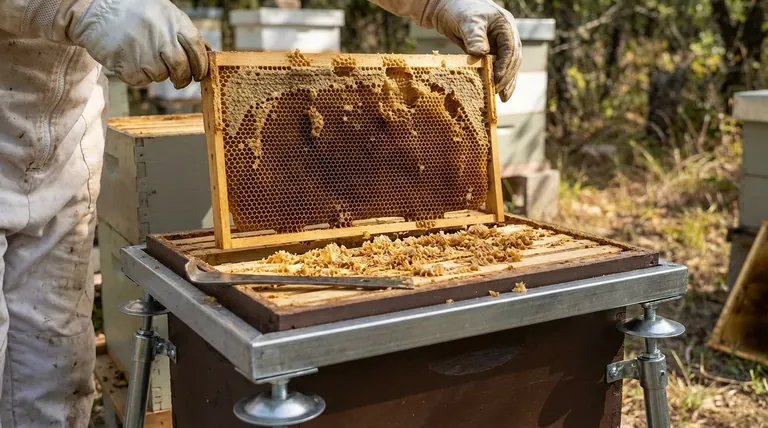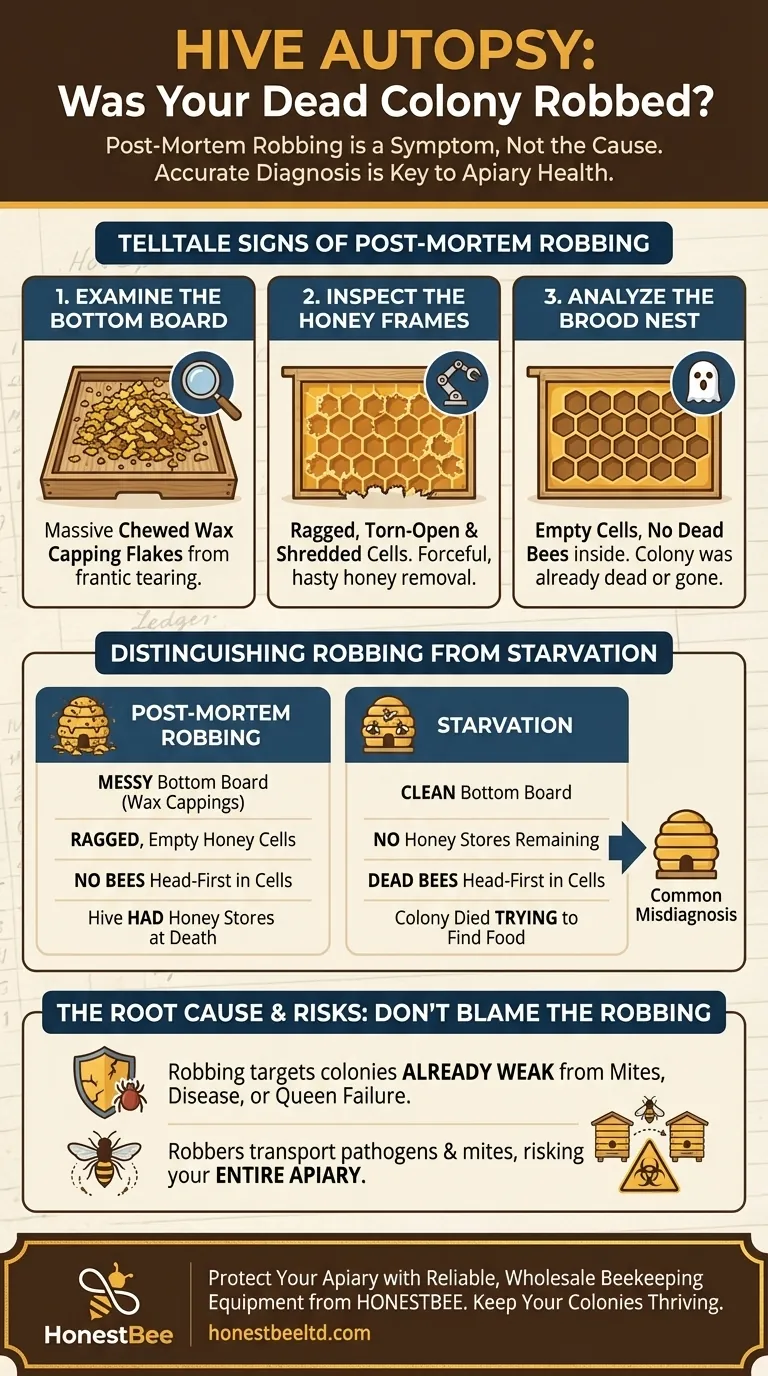To determine if a dead colony was robbed, you must examine the evidence left on the bottom board and in the combs. The key signs are a large amount of chewed wax flakes on the bottom board, ragged and torn-open honey cells, and a distinct lack of dead bees inside the cells where the brood would have been. These clues point to a "post-mortem" robbing, where a colony died from another cause and was subsequently cleaned out by neighboring bees.
The most critical insight is that robbing is often a symptom, not the cause, of a colony's death. Distinguishing between a colony that was robbed after it died versus one that died from robbing is essential for accurately diagnosing the root problem and protecting your remaining hives.

The Telltale Signs of a Post-Mortem Robbing
When a colony dies from issues like disease, queen failure, or freezing, its honey stores become a free resource for any strong, nearby hive. The robbers leave behind a distinct set of clues that look very different from other causes of death, like starvation.
Examining the Bottom Board
The bottom board is your first source of evidence. Robbing bees are frantic and messy, unlike the colony's original inhabitants.
You will find a large quantity of chewed wax capping flakes scattered across the board. Robbers tear, shred, and chew open the wax cappings to get to the honey, leaving behind significant debris. A few dead bees may also be present from fighting that occurred if the colony had a few remaining defenders.
Inspecting the Honey Frames
The appearance of the honeycombs is a definitive sign. Robbers are not careful with the hive's infrastructure.
You will see ragged, torn, and shredded edges on the cells that once held honey. This damage is a result of the forceful and hasty removal of honey. The frames will feel dry and completely empty of nectar or honey.
Analyzing the Brood Nest
The brood area provides the final piece of the puzzle. Where the dead bees are—or are not—is crucial.
The brood cells will be empty but otherwise intact. A healthy colony that dies from another cause will have its resources robbed, but the bees themselves will have already been removed by undertaker bees from the robbing colony, or will have died and fallen to the bottom board.
Distinguishing Robbing from Starvation
A common misdiagnosis is confusing a robbed-out colony with one that starved. The evidence they leave behind is nearly opposite, and understanding the difference points you to the true cause of failure.
The Starvation Scenario
A colony that starves to death will have a very clean bottom board because the bees consumed every last resource, including cleaning up any fallen crumbs of wax or sugar.
Crucially, you will find many dead bees head-first inside the cells. In a final, desperate attempt to find food, they crawl into cells and die there. The hive will have no honey stores remaining.
The Post-Mortem Robbing Scenario
A colony that was robbed after it died presents a much messier picture. The key is that the colony likely died with significant honey stores still in the hive.
This is why you find wax cappings on the bottom board—the robbers had to tear them open. The absence of bees head-first in cells shows the colony was already dead or gone before the robbing frenzy began.
Common Pitfalls to Avoid
Accurately identifying the sequence of events—death first, robbing second—is vital. Blaming the robbing itself can cause you to overlook the underlying issue that truly killed your bees.
Misdiagnosing the Root Cause
It's easy to see an empty, damaged hive and conclude "robbing killed them." This is rarely the case for an otherwise healthy colony.
A strong hive can easily defend itself. Robbing is a crime of opportunity that occurs when a hive is already too weak to mount a defense due to a more serious problem, such as a high Varroa mite load, disease, or a failing queen.
Ignoring the Risk to Your Apiary
If a colony died from a disease like American Foulbrood (AFB) and was subsequently robbed, the robbing bees have now become carriers.
They will transport pathogens and Varroa mites back to their own healthy colonies. This makes an accurate "hive autopsy" essential not just for understanding one loss, but for protecting the health of your entire apiary.
Making the Right Diagnosis for Your Apiary
Use the evidence in the hive to work backward and understand the story of the colony's collapse. This will inform how you manage your remaining hives.
- If your primary focus is confirming post-mortem robbing: Look for the classic signs of messy wax debris on the bottom board and torn-open honey cells on the frames.
- If your primary focus is preventing future losses: Look past the robbing and find the original weakness. A proper diagnosis of the initial cause of death—be it mites, disease, or queen issues—is the only way to prevent it from happening again.
Understanding why a colony truly failed is the cornerstone of responsible and sustainable beekeeping.
Summary Table:
| Signs of Post-Mortem Robbing | Signs of Starvation |
|---|---|
| Chewed wax flakes on bottom board | Clean bottom board |
| Ragged, torn honey cells | Dead bees head-first in cells |
| Empty brood cells (no dead bees) | No honey stores remaining |
Protect Your Apiary with the Right Equipment
Accurate diagnosis is key to sustainable beekeeping. Equip your operation with durable, reliable supplies from HONESTBEE. We supply commercial apiaries and distributors with wholesale-focused beekeeping equipment designed to support hive health and productivity.
Contact our team today to discuss your wholesale needs and keep your colonies thriving.
Visual Guide

Related Products
- Metal Hive Feet Bee Hive Stand for Ant Protection
- Professional Insulated Winter Hive Wrap for Beekeeping
- Yellow Plastic Bucket Pail Perch for Beekeeping
- Professional Engraved Round Hive Number Tags for Beekeeping
- Heavy-Duty Stainless Steel Clip-On Frame Perch
People Also Ask
- Why should beekeepers consider using hive stands? Protect Your Hives and Your Back
- How can hive stands be made more secure in windy areas? Anchor Your Apiary Against the Elements
- What is the role of oxalic acid in plants? A Key to Plant Defense and Internal Regulation
- How do bees regulate ventilation and temperature in the hive? Master Hive Climate Control
- What is the best stand for a beehive? A Practical Guide to Durability & Stability



















